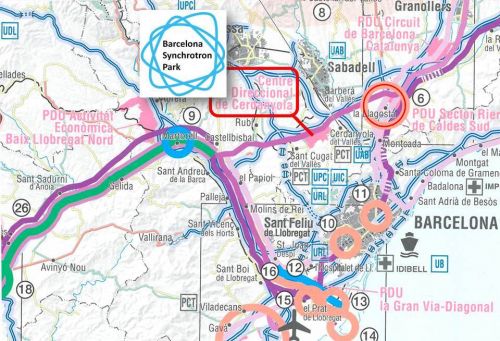
02/06/2016
Mediterranean Corridor: an important infrastructure for Barcelona Synchrotron Park
Mediterranean Corridor: an important infrastructure for Barcelona Synchrotron Park
In the European Union, railway represents 18.4% of the freight transport, 3 times more than in Spain (5.2%).
Carrying out the Mediterranean corridor would be decisive in order to increase the Spanish percentage in favor of this sustainable way of transporting goods (less pollution, less CO2, less accident than for trucks).
This international European gauge railway corridor aims to connect the port of Cadiz (south of Spain) with the port of Barcelona (north), via the ports of Malaga, Almeria, Valencia, Tarragona etc., before continuing to France and the rest of Europe. This railway, which would link all the Mediterranean Spanish border regions, would connect 48% of the Spanish population, 44% of its GDP, 49% of its importations and 51% of its exportations.
This railway corridor is one of the key elements of the Trans-European Transport Network (TEN-T) designed in Brussels. In order to accelerate its execution, the Catalan government has recently created a table, the so-called Mediterranean Corridor Strategic Table that includes a 5.6 billion Euros investment just in Catalonia.
Among the different documents (in Catalan) prepared for this table (all data included in this news were taken from them), a map details the Mediterranean corridor in Catalonia. As far as Barcelona is concerned, it can be seen (see image) that one of the corridor section leaves from the port, runs along the Barcelona Synchrotron Park (“Centre direccional de Cerdanyol” shown on the map corresponds to the local administrative name of the park) and connects to La Llagosta (20 minutes far from the park) where an intermodal station for trains and trucks will be constructed by 2020 as a priority infrastructure.
Very good news for Barcelona Synchrotron Park, its territory and its companies.
Carrying out the Mediterranean corridor would be decisive in order to increase the Spanish percentage in favor of this sustainable way of transporting goods (less pollution, less CO2, less accident than for trucks).
This international European gauge railway corridor aims to connect the port of Cadiz (south of Spain) with the port of Barcelona (north), via the ports of Malaga, Almeria, Valencia, Tarragona etc., before continuing to France and the rest of Europe. This railway, which would link all the Mediterranean Spanish border regions, would connect 48% of the Spanish population, 44% of its GDP, 49% of its importations and 51% of its exportations.
This railway corridor is one of the key elements of the Trans-European Transport Network (TEN-T) designed in Brussels. In order to accelerate its execution, the Catalan government has recently created a table, the so-called Mediterranean Corridor Strategic Table that includes a 5.6 billion Euros investment just in Catalonia.
Among the different documents (in Catalan) prepared for this table (all data included in this news were taken from them), a map details the Mediterranean corridor in Catalonia. As far as Barcelona is concerned, it can be seen (see image) that one of the corridor section leaves from the port, runs along the Barcelona Synchrotron Park (“Centre direccional de Cerdanyol” shown on the map corresponds to the local administrative name of the park) and connects to La Llagosta (20 minutes far from the park) where an intermodal station for trains and trucks will be constructed by 2020 as a priority infrastructure.
Very good news for Barcelona Synchrotron Park, its territory and its companies.
More news
23/06/2016
Distributed Polygeneration: Barcelona Synchrotron Park Shares Its Experience
17/06/2016
Barcelona Synchrotron Park Sponsors the Fifth Ideas Generation Program
10/06/2016
The Nanoworld Is Designed and Observed In and Nearby Barcelona Synchrotron Park
02/06/2016
Mediterranean Corridor: an important infrastructure for Barcelona Synchrotron Park
26/05/2016
UAB University Makes Distance Wireless Charging a Reality
19/05/2016
HP Enters the 3D Printing Market









